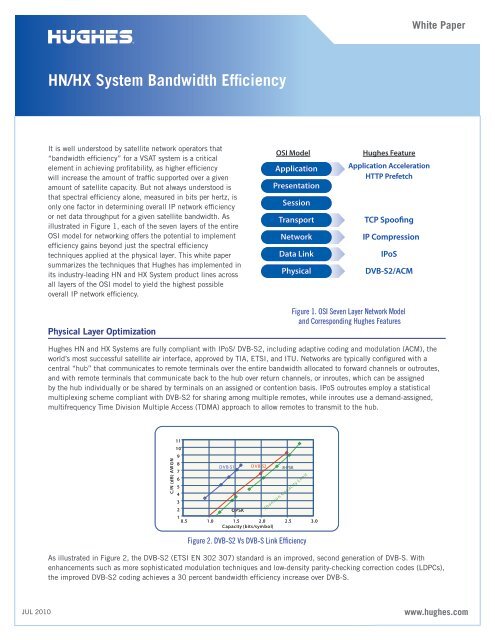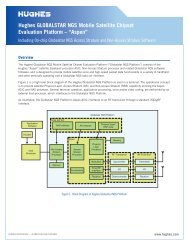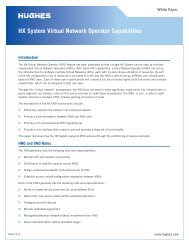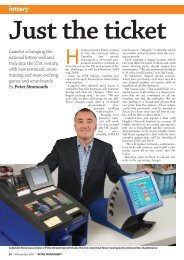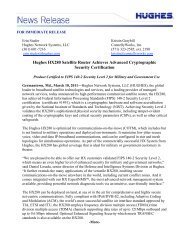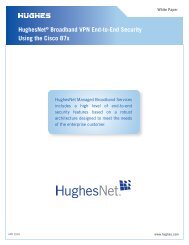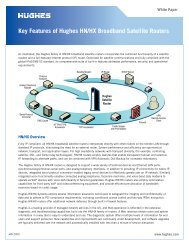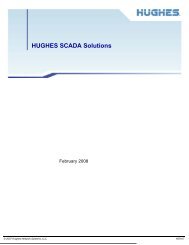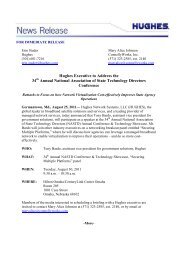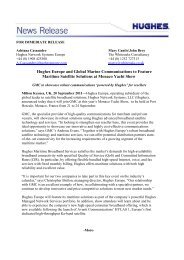HN/HX System Bandwidth Efficiency - Hughes Network Systems, LLC
HN/HX System Bandwidth Efficiency - Hughes Network Systems, LLC
HN/HX System Bandwidth Efficiency - Hughes Network Systems, LLC
You also want an ePaper? Increase the reach of your titles
YUMPU automatically turns print PDFs into web optimized ePapers that Google loves.
JUL 2010<br />
<strong>HN</strong>/<strong>HX</strong> <strong>System</strong> <strong>Bandwidth</strong> <strong>Efficiency</strong><br />
It is well understood by satellite network operators that<br />
“bandwidth efficiency” for a VSAT system is a critical<br />
element in achieving profitability, as higher efficiency<br />
will increase the amount of traffic supported over a given<br />
amount of satellite capacity. But not always understood is<br />
that spectral efficiency alone, measured in bits per hertz, is<br />
only one factor in determining overall IP network efficiency<br />
or net data throughput for a given satellite bandwidth. As<br />
illustrated in Figure 1, each of the seven layers of the entire<br />
OSI model for networking offers the potential to implement<br />
efficiency gains beyond just the spectral efficiency<br />
techniques applied at the physical layer. This white paper<br />
summarizes the techniques that <strong>Hughes</strong> has implemented in<br />
its industry-leading <strong>HN</strong> and <strong>HX</strong> <strong>System</strong> product lines across<br />
all layers of the OSI model to yield the highest possible<br />
overall IP network efficiency.<br />
Physical Layer Optimization<br />
White Paper<br />
<strong>Hughes</strong> <strong>HN</strong> and <strong>HX</strong> <strong>System</strong>s are fully compliant with IPoS/ DVB-S2, including adaptive coding and modulation (ACM), the<br />
world’s most successful satellite air interface, approved by TIA, ETSI, and ITU. <strong>Network</strong>s are typically configured with a<br />
central “hub” that communicates to remote terminals over the entire bandwidth allocated to forward channels or outroutes,<br />
and with remote terminals that communicate back to the hub over return channels, or inroutes, which can be assigned<br />
by the hub individually or be shared by terminals on an assigned or contention basis. IPoS outroutes employ a statistical<br />
multiplexing scheme compliant with DVB-S2 for sharing among multiple remotes, while inroutes use a demand-assigned,<br />
multifrequency Time Division Multiple Access (TDMA) approach to allow remotes to transmit to the hub.<br />
C /N (dB) AW G N<br />
OSI Model<br />
Application<br />
Presentation<br />
Session<br />
11<br />
10<br />
9<br />
8<br />
7<br />
6<br />
5<br />
4<br />
3<br />
D VB-S1 D VB-S2 8-PSK<br />
2<br />
Q PSK<br />
1<br />
0.5 1.0 1.5 2.0 2.5 3.0<br />
C apacity (bits/sym bol)<br />
Shanno n C apacity Lim it<br />
Figure 2. DVB-S2 Vs DVB-S Link <strong>Efficiency</strong><br />
<strong>Hughes</strong> Feature<br />
Application Acceleration<br />
HTTP Prefetch<br />
Transport TCP Spoo�ng<br />
<strong>Network</strong> IP Compression<br />
Data Link IPoS<br />
Physical DVB-S2/ACM<br />
Figure 1. OSI Seven Layer <strong>Network</strong> Model<br />
and Corresponding <strong>Hughes</strong> Features<br />
As illustrated in Figure 2, the DVB-S2 (ETSI EN 302 307) standard is an improved, second generation of DVB-S. With<br />
enhancements such as more sophisticated modulation techniques and low-density parity-checking correction codes (LDPCs),<br />
the improved DVB-S2 coding achieves a 30 percent bandwidth efficiency increase over DVB-S.<br />
www.hughes.com
<strong>HN</strong>/<strong>HX</strong> SYSTEM BANDWIDTH EFFICIENCY 2<br />
White Paper<br />
In addition to the improved efficiency achieved by using LDPC, DVB-S2 enables the use of “Adaptive Coding and<br />
Modulation” or ACM. ACM allows the system to dynamically vary the modulation and coding of the forward channel for<br />
each transmission. Using information gained via a closed loop feedback mechanism from the remote to the hub enables the<br />
system to transmit to each remote using the optimal combination of coding and modulation.<br />
NOC<br />
Signal Quality<br />
Measurement<br />
and Rain Fade<br />
Detection<br />
8PSK 8PSK Rate Rate 9/10 9/10<br />
8PSK 8PSK Rate Rate 3/4 3/4<br />
8PSK 8PSK Rate Rate 1/2 1/2<br />
8PSK 8PSK Rate Rate 9/10 9/10<br />
8PSK 8PSK Rate Rate 3/4 3/4<br />
Benefits<br />
• Power Conservation<br />
• Availability 8PSK<br />
Rate 1/2<br />
Remotes<br />
Figure 3. ACM Feature of the IPoS/DVB-S2 Standard<br />
8PSK<br />
Rate 9/10<br />
Remotes<br />
8PSK 8PSK Rate Rate 1/2 1/2<br />
8PSK<br />
Rate 3/4<br />
Remotes<br />
As shown in Figure 3, the remote terminal continuously evaluates signal quality to determine the optimal modulation and<br />
coding (also known as “modcod”) for the hub station to send data to that remote terminal. When conditions change or if the<br />
hub is not sending data at the optimal modcod, the remote will append a flag on return channel messages indicating that a<br />
different modcod should be used. In a rain condition, the hub can automatically adjust the modcod for the affected remote<br />
sites, allowing data transmission to continue, albeit at a lower rate for a short period of time. This is a very powerful feature<br />
because it allows satellite operators to size their networks to optimize individual site performance rather than be degraded to<br />
support the lowest performing site in the network. Additionally, higher availability across the network can be achieved with<br />
smaller antennas. Use of ACM provides up to 30 percent bandwidth gain on top of the 30 percent gain provided by LDPC.<br />
For the return channels, which as noted use a multifrequency, TDMA Access (FD/TDMA) scheme, <strong>Hughes</strong> also offers shortblock,<br />
low-latency, Low-Density Parity Check (LDPC) codes. As illustrated in Figure 4, using LDPC on these return channels<br />
enables <strong>Hughes</strong> to achieve an 8–12 percent bandwidth efficiency increase over existing Turbo Coded return channel systems.<br />
KHz<br />
1,000<br />
800<br />
600<br />
400<br />
200<br />
1<br />
1<br />
Improved bandwidth usage with LDPC coding over Turbo coding<br />
(example at 512 ksps)<br />
2<br />
3<br />
4<br />
5<br />
6<br />
Es/No<br />
Figure 4. LDPC vs. Turbo Return Link <strong>Efficiency</strong><br />
7<br />
8 9 10<br />
LDPC Turbo<br />
www.hughes.com
<strong>HN</strong>/<strong>HX</strong> SYSTEM BANDWIDTH EFFICIENCY 3<br />
White Paper<br />
To improve the spectral efficiency further for the return channel, <strong>Hughes</strong> has implemented “adaptive coding” on the<br />
return channel. Similar to ACM on the forward channel, adaptive coding on the return channel enables a remote terminal<br />
to dynamically adjust its transmissions to handle fade conditions in parallel with the hub using ACM to handle forward<br />
channel fade. Remote terminals also can be dynamically assigned to a return channel using a different symbol rate for better<br />
performance.<br />
With adaptive coding, also known as “Code Rate Change on the Fly,” the return channel demodulator is able to demodulate<br />
all bursts on the same channel, no matter what coding rate is used. The remote terminal, using feedback from the hub<br />
including the received Es/No levels, selects the most efficient coding rate that enables the transmission to be received by the<br />
demodulator without error. For some remote terminals this may be Rate 2/3, for other remote terminals, Rate 4/5, and for<br />
others, Rate 1/2. Using Adaptive Coding typically gives a satellite operator 20 percent increased throughput over the satellite<br />
because the return channel coding rate does not have to be configured with extra rain fade margin.<br />
As outlined above, <strong>Hughes</strong> has implemented the most powerful modem coding schemes available in order to achieve<br />
the highest possible spectral efficiency. But <strong>Hughes</strong> also applies a number of powerful techniques at higher layers of the<br />
OSI model. The application of these techniques is not reflected in a higher spectral efficiency, but rather in a higher IP<br />
throughput figure.<br />
Data Link Optimization<br />
While the physical layer optimization increases spectrum efficiency, <strong>HN</strong> and <strong>HX</strong> <strong>System</strong>s further employ a number of<br />
optimization techniques to maximize the use of available bandwidth for user IP traffic. As noted above, bandwidth efficiency<br />
is more than the theoretical calculation of bits per hertz. <strong>Bandwidth</strong> efficiency can be considered as the percentage of<br />
available bandwidth used for user IP traffic. <strong>Bandwidth</strong> efficiency is diminished if bandwidth is allocated and unused due to<br />
control and signaling overhead.<br />
<strong>Hughes</strong> typically achieves 85 percent bandwidth packing efficiency on the return channel. The efficiency of the return<br />
channel is achieved by using a variable burst length architecture and use of a contention channel (Aloha) via which a<br />
satellite terminal requests bandwidth and becomes active in the network. The use of Aloha allows <strong>Hughes</strong> to operate without<br />
dedicated bandwidth for idle terminals, providing significant bandwidth savings. The <strong>HN</strong> and <strong>HX</strong> <strong>System</strong>s use real-time<br />
bandwidth allocation algorithms to determine how much bandwidth to allocate to the terminals for return channel burst<br />
transmissions. A variable length burst architecture allows bandwidth allocation to be tailored to the exact size required by a<br />
terminal to send user traffic.<br />
The return channel allocation granularity supported in the <strong>HN</strong> and <strong>HX</strong> <strong>System</strong>s is one TDMA time slot, and the minimum<br />
allowed burst size consists of three such time slots. One TDMA slot typically carries 15 bytes of user data. This type of<br />
allocation with smaller granularity provides a statistically better packing efficiency for user data when compared with the 53<br />
bytes, ATM cell granularity for DVB-RCS, or some higher values of allocation granularity, such as 125 bytes for other vendors’<br />
proprietary implementations. Figure 5 compares return channel packing efficiencies between <strong>Hughes</strong> and others mentioned<br />
above for various sizes of user packets, representing a typical satellite system used mainly for Internet access.<br />
E�ciency in %<br />
100<br />
90<br />
80<br />
70<br />
60<br />
50<br />
40<br />
30<br />
55<br />
80<br />
Packing E�ciency vs. Packet Size<br />
172 800 1132 1460<br />
Packet Size<br />
<strong>Hughes</strong> ATM 125 bytes<br />
Figure 5. Return Channel Packing Efficiencies<br />
www.hughes.com
<strong>HN</strong>/<strong>HX</strong> SYSTEM BANDWIDTH EFFICIENCY 4<br />
White Paper<br />
As can be seen from the chart, <strong>Hughes</strong> achieves much higher packing efficiencies as packet sizes become smaller. Internet<br />
access and VoIP support are two key applications driving the growth of satellite networks around the world. In the case of<br />
Internet access, most of the return channel traffic consists of very small packets containing “gets,” while VoIP packets are<br />
even smaller. Thus, the <strong>Hughes</strong> TDMA access scheme generates higher efficiencies for these applications.<br />
<strong>Network</strong> Layer Optimization<br />
<strong>HN</strong> and <strong>HX</strong> <strong>System</strong>s deliver more user data over a given available satellite link capacity by incorporating various bandwidth<br />
optimization techniques at the network layer, both in the forward and return directions.<br />
The Performance Enhancing Proxy (PEP) uses standard (RFC 3135) mechanisms for TCP ACK reduction and three-way<br />
handshaking, but has expansions beyond the standard to maximize “filling of the pipe” without congestion. The system also<br />
supports industry standard (RFC 3095) header compression tuned to the satellite link for IP, TCP, UDP, and RTP protocol<br />
suites. In addition, the ITU V.44 algorithm (a <strong>Hughes</strong> patent) used for payload compression provides another 40 percent<br />
efficiency gain on top of the gain provided by the header compression for compressible payload data, particularly with Web<br />
traffic. It should be noted that the V.44 scheme enables higher efficiency than other schemes such as “GZIP”.<br />
Other techniques to generate efficiency include DNS caching and preload, where the DNS information is stored in the<br />
remote terminal and thereby eliminates the need for a transmission across the satellite.<br />
TurboPage ®<br />
HTTP Prefetch, which is marketed by <strong>Hughes</strong> as TurboPage, is an application acceleration feature which enhances the<br />
performance of the HTTP (Web browser) protocol by pre-fetching the HTML (Hypertext Markup Language) objects embedded<br />
in a Web page into the remote terminal before the application requests them. This feature uses a hub traffic server to<br />
request HTTP objects in advance and on behalf of browsers at the remote terminal. The proxy server pushes these objects<br />
to the remote VSAT where it is cached and, therefore, immediately available when the client browser requests the object.<br />
This concept is illustrated in Figure 6 below. This feature provides exceptionally better user experience as Web pages are<br />
“painted” more quickly.<br />
PC Web Browser<br />
TIME<br />
Request Object 1<br />
Deliver Object 1<br />
Request Object 2<br />
Deliver Object 2<br />
Request Object n<br />
Deliver Object n<br />
<strong>HN</strong>/<strong>HX</strong> VSAT<br />
Cache<br />
Figure 6. HTTP Prefetch<br />
TurboPage® Server<br />
Prefetch Object 2<br />
Prefetch Object n<br />
HTTP Prefetch is primarily aimed at improving web page response time rather than at improving bandwidth efficiency.<br />
However, it does contribute to the latter is two ways. First, because objects are pre-fetched, GET requests for the objects do<br />
not need to sent across the return channel thus conserving bandwidth. Second, HTTP Prefetch applies V.44 compression to<br />
HTTP objects as they are forwarded, reducing forward channel bandwidth requirements.<br />
www.hughes.com
Application Layer Optimization<br />
<strong>HN</strong>/<strong>HX</strong> SYSTEM BANDWIDTH EFFICIENCY 5<br />
White Paper<br />
In addition to the payload optimization techniques already mentioned, <strong>Hughes</strong> has also implemented “Web Optimizers,”<br />
which work at the HTTP layer and are able to compress HTTP content. A Web Optimizer is typically implemented as a server<br />
at the <strong>HN</strong> or <strong>HX</strong> hub station and applies a number of data-specific compression techniques including image compression for<br />
JPG and GIF images. Through the application of the Web Optimizer, <strong>Hughes</strong> can reduce HTTP traffic volume by up to<br />
30 percent. It should be noted that the application of compression on images results in loss of image quality. The higher the<br />
compression savings the greater the impact to image quality. Figure 7 illustrates that the Web Optimizer is placed between<br />
the Internet and the satellite network hub.<br />
Conclusion<br />
Internet<br />
100 Mbps<br />
<strong>Hughes</strong><br />
Web<br />
Optimizer<br />
80 Mbps<br />
Figure 7. Web Optimizer Implementation<br />
<strong>Hughes</strong><br />
<strong>HN</strong> or <strong>HX</strong> Hub<br />
Together, the combination of all the techniques described above results in significant efficiencies for overall IP throughput.<br />
Perhaps the best way to illustrate these savings is to look at a specific customer example. <strong>Hughes</strong> implemented a customer<br />
network with a DVB-S2 forward channel on 45 MHz of satellite capacity. The average satellite channel throughput over<br />
the forward channel achieved is about 90 Mbps. In this customer’s network there are 74 return channels, with each return<br />
channel operating at 256 ksps. Approximately half of the remotes in the network are able to transmit over the return channel<br />
using Rate 2/3, and the other half are able to transmit using Rate 1/2 coding. Thus, the overall return channel capacity is<br />
about 22 Mbps over 26 MHz. From the forward channel and return channel figures noted above, we can quickly calculate<br />
spectral efficiency at 1.9 bits per hertz for the forward channel and about .8 bits per hertz for the return channel.<br />
But, as can be seen in Figure 8 below, the actual network throughput is much higher than what the spectral efficiency figure<br />
would otherwise indicate. The service operator of this network is actually driving 149 Mbps of IP content into the system in<br />
the forward channel direction. Applying 149 Mbps against 45 MHz gives us an IP efficiency of 3.2 bits per hertz, or over<br />
50 percent higher throughput than indicated by spectral efficiency alone. In the return channel, the system carries 30 Mbps<br />
of IP content over the 26 MHz of return channel capacity, resulting in an IP efficiency of 1.13 bits per hertz, which is about<br />
30 percent higher throughput than indicated by spectral efficiency alone.<br />
Internet<br />
149 Mbps<br />
<strong>Hughes</strong><br />
Web<br />
Optimizer<br />
140 Mbps<br />
30 Mbps<br />
<strong>Hughes</strong><br />
<strong>HN</strong> or <strong>HX</strong> Hub<br />
90 Mbps<br />
22 Mbps<br />
HTTP content compression IP payload compression<br />
TCP/IP/RTP/UDP header compression<br />
TCP acceleration<br />
Figure 8. Compression <strong>Efficiency</strong><br />
140 Mbps<br />
30 Mbps<br />
www.hughes.com
Proprietary Statement<br />
All rights reserved. This publication and its contents are proprietary to <strong>Hughes</strong> <strong>Network</strong> <strong>System</strong>s, <strong>LLC</strong>. No part of this publication may<br />
be reproduced in any form or by any means without the written permission of <strong>Hughes</strong> <strong>Network</strong> <strong>System</strong>s, <strong>LLC</strong>, 11717 Exploration Lane,<br />
Germantown, Maryland 20876.<br />
HUGHES and TurboPage are registered trademarks of <strong>Hughes</strong> <strong>Network</strong> <strong>System</strong>s, <strong>LLC</strong>.<br />
©2010 <strong>Hughes</strong> <strong>Network</strong> <strong>System</strong>s. <strong>LLC</strong>. All information is subject to change. All rights reserved.<br />
<strong>HN</strong>/<strong>HX</strong> SYSTEM BANDWIDTH EFFICIENCY<br />
HUGHES PROPRIETARY H43725 ID JUL 10<br />
White Paper<br />
The overall efficiency of a VSAT network is the product of much more than just spectral efficiency at the physical layer, and<br />
operators should fully understand all the capabilities and efficiencies in assessing a vendor’s products. <strong>Hughes</strong> <strong>HN</strong> and<br />
<strong>HX</strong> <strong>System</strong>s employ an extensive set of efficiency techniques across all communication layers to yield the highest possible<br />
overall IP network efficiency.<br />
6<br />
www.hughes.com<br />
11717 Exploration Lane Germantown, MD 20876 USA


